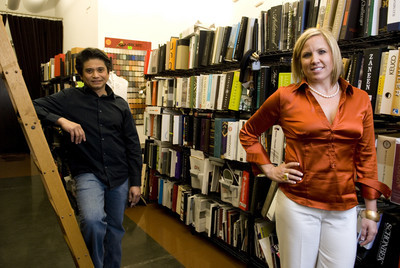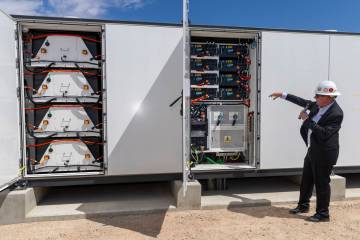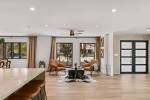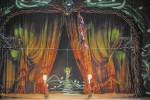At crossing of contemporary and comfortable, duo finds creativity
As colleagues at two big local resort-architecture firms, Kim Daoust and Jordan Bañares designed interiors in tandem.
Their joint projects, first with the Friedmutter Group and then with Steelman Partners, took them all over the country, from California to the Gulf Coast.
The two worked so well as a team that in 2005, tandem morphed from a mere description of their business partnership into the name of their new interior-design business.
Today, Tandem can claim a portfolio featuring interior-design work on Santa Fe Station, the Palms, Reno's Atlantis, the Pala Casino in San Diego and the Koa'kea hotel in Kauai, Hawaii. And though business has slowed as casino development has stalled, the partners say they're ready for a potential wave of new projects as resort operators look to renovate interiors rather than rebuild properties.
Question: You worked on several projects together for different companies. How did you decide to open a business together?
Daoust: Our biggest project at Paul Steelman was a design of the Hard Rock Biloxi pre-Katrina. We worked on that project hand in hand. At that point, we started seeing it just took the two of us to run a project.
Bañares: Without the principals of the firm.
Daoust: We just did it and it worked. Another project we were working on locally was the Silverton. We really were sort of given carte blanche. We would just report back. Things went so well and the clients seemed to be really happy with the way we approached projects as a team. So we thought there's really a niche here for the smaller, boutique-style studio. At that point, there weren't many of those types of principals-hands-on firms.
Bañares: It was still a leap of faith. Each of us has families to feed. But we just said, "Let's do it."
Question: What was that conversation like? Did you hash out a plan on the back of a napkin over lunch?
Daoust: It happened driving back from a meeting on the Silverton project. We were in the car saying, "We can do this."
Question: What makes you compatible as business partners?
Bañares: We share an approach to design that there should always be a balance between what's cool, hip or contemporary, and elements that are warm and textured and tactile and inviting.
Daoust: Our strengths complement each other. He's really great in high concepts and rendering on more of the architectural side. When we started working together, it inspired me to get more into the interior architecture of the space as opposed to just the finishes and materials and furniture and fluff that go with it. He wanted my involvement. At that point, we really started meshing. We could start planning space together, and he would take my input on architecture, and I would take his input on materials and furniture styles.
Bañares: And then it's easy to sell to the client, because it's a complete package.
Daoust: It comes from both sides. You've got the finishes and the interior architecture.
Question: How has a weaker economy changed your operation?
Bañares: During our first year, we had to do barely any marketing. The economy was good and word was out that we formed our own company.
Daoust: It's more competitive today. We don't believe the market is going to see a lot of the big, billion-dollar jobs, or even $100 million jobs, happening. We're going to see smaller projects. We may see more interior renovations as opposed to new construction, and that's really good for us. To stay competitive and fresh, hotels and casinos will have to renovate. On the other hand, some of the bigger firms that might not have looked for the smaller, renovation-type projects will now be looking at those jobs as business opportunities.
Bañares: That we're local will now be more of an advantage. The past three or four years, owners have been getting designers from New York and Los Angeles, and they're high-profile designers, which means higher fees. But it's not just an expense issue. It's also the local designer's response to owners. When designers are nearby, you don't have to fly them out. We're here. We're a phone call away.
Question: Do you always see eye to eye on design and the business? How do you keep sticking points from causing bigger problems in your working relationship?
Daoust: For sure, we don't always see eye to eye. Actually, more often than not, we don't. We just offer our arguments.
Bañares: We have creative differences, but that creates a check and balance, and it pushes us to the next level of design.
Question: Who usually wins arguments?
Daoust: I think it depends on who has the most passion for the discussion.
Bañares: I think seniority rules! Actually, we're both open-minded when it comes to design, and what's practical or what's inventive.
Question: What's the secret to making sure things stay friendly?
Daoust: Respect and admiration. When I met Jordan, he was very inspiring. He's designed a lot of five-star properties and boutique properties. He has a larger knowledge base. I think he respects me for what I do and the decisions I make. And we're friends.
Question: What are your different strengths operationally?
Daoust: I handle more of the business end, and Jordan entrusts that to me. He likes to stay more at the creative end. We talk about all the issues when it comes to business, but really, it's me heading it up.
Bañares: My strength on the business side is getting out of the way. Actually, I keep her level-headed. She's the more fiery, emotional one. I'll be the yang and she'll be the yin. It's a balance.
Question: Where's your business headed in the future? How would you like to grow?
Daoust: Ten years from now, we would still want to be a boutique firm, in contrast to what we thought three years ago. Back then, we wanted to be the biggest and the best, with offices in all the metropolitan cities, and to be worldwide. We've regrouped on that thought. We want to just give great service and design. We want to be the best at design, but on a boutique level. It's not about how many projects we do anymore. It's about the quality of the projects we do.
Bañares: We still want to be hands-on.
Daoust: And the clients respect and appreciate that. It's very easy to get too much going on and then you sort of have to walk away from being hands-on. We'd love to do projects around the world, but stay in a more boutique environment. Being the biggest is not so important anymore. We formed Tandem because we love interior design and we're very passionate about it. We want to continue to be involved in the interior design of our projects, and it's difficult enough to find a balance between running the business and then doing the design. I think that balance is in keeping Tandem boutique-size.
Contact reporter Jennifer Robison at jrobison@reviewjournal.com or 702-380-4512.
VITAL STATISTICS
Name: KIM DAOUST
Age: 36
Position: Principal and partner, Tandem
Quotable: "Our strengths complement each other."
Family: Husband, Chad; daughter, Morgan; son, Rylee
Education: Bachelor's degree in interior design, Northern Arizona University
Work history: Design librarian, assistant interior designer, interior designer, creative director of interior design, Steelman Partners, Las Vegas; senior project interior designer, Friedmutter Group, Las Vegas
Hobbies: Working out, shopping, spending time with family
Favorite book: "The Secret," by Rhonda Byrne, or "Pour Your Heart Into It: How Starbucks Built a Company One Cup at a Time," by Howard Schultz and Dori Jones Yang
Hometown: Glendale, Ariz.
In Las Vegas since: 1995
Name: JORDAN BAÑARES
Age: 47
Position: Partner and designer, Tandem
Quotable: " ... we're both open-minded when it comes to design ... "
Family: Wife, Linda; daughter, Jerica; son, Jared
Education: Bachelor's degree in architecture, University of the Philippines
Work history: Interior designer, Anita Brooks Interiors, Pasadena, Calif.; senior designer, Friedmutter Group, Las Vegas; project designer, Steelman Partners, Las Vegas
Hobbies: Photography, golf
Favorite book: "The Fountainhead," by Ayn Rand
Hometown: Quezon City, the Philippines
In Las Vegas since: 1998




























